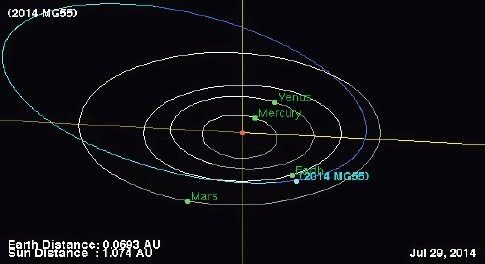At least 41 people have died and between 120 and 350 are missing after a landslide destroyed the village of Malin, about 80 km north of Pune in Maharashtra State, on the morning of Wednesday 30 July 2014. The incident occurred after about two days of heavy rains, and continuing rain is said to be severely hampering rescue attempts. Landslides are a common problem after severe weather events, as excess pore water pressure can overcome cohesion in soil and sediments, allowing them to flow like liquids. Approximately 90% of all landslides are caused by heavy rainfall.
The scene of the Malin landslide on Wednesday 30 July 2014. AP/Press Trust of India.
July is peak monsoon season in Pune District, with an average monthly rainfall of 187.2 mm, out of an annual average of 721.7. This year, however, rainfall in the area has been exceptionally high with 83 mm falling in the 24 fours prior to the landslide. The situation is thought to have been made worse by extensive deforestation in the area, with trees being harvested in an unregulated way for timber for use in the construction and mining industries. Tree roots can help to hold soft sediments together on slopes, and deforestation is often associated with landslides.
Rescue workers at the scene of the Malin landslide on Wednesday 30 July 2014. Hindustan Times.
The approximate location of the 30 July 2014 Malin landslide. Google Maps.
See also...
 Five dead after landslide at Antop Hill, Mumbai.
Five dead after landslide at Antop Hill, Mumbai.
Five people have died following a landslide in the Antop Hill area of central Mumbai on Wednesday 10 July 2013. The incident happened...
 Man killed in Kerala Landslide.
Man killed in Kerala Landslide.
A man was killed when a landslide struck a the Rocha Hotel in the resort town of Munnar in the Idukki District of Kerala State, India at around 3.30 am on Tuesday 25 June local time (10.00 pm on Monday 24 June, GMT). He has been named as Zakariahkutty, a chef in his...
 Three workers killed in landslide at Mumbai quarry.
Three workers killed in landslide at Mumbai quarry.
Three workers have been killed, and a further two injured, in a landslide at a quarry in Navi Mumbai (a satelite town of Mumbai)...
Follow Sciency Thoughts on Facebook.
 Five dead after landslide at Antop Hill, Mumbai.
Five dead after landslide at Antop Hill, Mumbai.Five people have died following a landslide in the Antop Hill area of central Mumbai on Wednesday 10 July 2013. The incident happened...
 Man killed in Kerala Landslide.
Man killed in Kerala Landslide.A man was killed when a landslide struck a the Rocha Hotel in the resort town of Munnar in the Idukki District of Kerala State, India at around 3.30 am on Tuesday 25 June local time (10.00 pm on Monday 24 June, GMT). He has been named as Zakariahkutty, a chef in his...
 Three workers killed in landslide at Mumbai quarry.
Three workers killed in landslide at Mumbai quarry.Three workers have been killed, and a further two injured, in a landslide at a quarry in Navi Mumbai (a satelite town of Mumbai)...
Follow Sciency Thoughts on Facebook.


















































